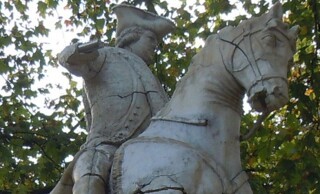At the Korean Cultural Centre
Rosemary Hill
There is nothing obviously odd about the generic military-man-on-a-horse partly visible through the nearly leafless trees in Cavendish Square. He is William, Duke of Cumberland (1721-65), and the plinth would lead you to believe his statue has been there since 1770. It hasn’t.
It was there from 1770 until 1868, by which time ‘Butcher’ Cumberland, the man responsible for the English atrocities after the Battle of Culloden, was a much-hated figure. There was no dramatic demolition, indeed there is still some doubt about what happened to the lead original, whether it was removed for repair and tactfully not replaced, or whether the fifth Duke of Portland had it melted down.
What is certain is that it went and its plinth stood empty for 144 years. The figure that now turns its horse’s handsome rump on the 21st-century square, John Lewis, RBS and Pret a Manger, has been there since last June. It is the work of the Korean sculptor Meekyoung Shin and it is made of soap. Here and there a bit of a limb has dropped off, revealing the steel armature, but otherwise it is in good shape. The plan was for it to be there a year, but in a striking reversal of its predecessor’s fate it is staying on by popular request. The statue is a gentle intervention, subtler than anything that has yet been made of the empty slot in Trafalgar Square. Its implied critique of the heroic, of fame and history, civic space, political art and national memory is left to play itself out, or not, in the minds of passers-by.
In Shin’s exhibition Unfixed, at the Korean Cultural Centre in London until 18 January, there are similarly interwoven strands of history and iconography, as well as a powerful smell of soap. The show is in three parts. The first and largest consists of vases and jars, standing on packing cases. They imitate ceramic, cloisonné and jade, and their transitional, intermediary nature is reinforced by the delivery labels and‘FRAGILE’ warnings stencilled on the crates. The theme has an autobiographical quality – Shin has lived in London since 1995 and says she no longer feels ‘strictly Korean’ – but there are also, as with Cumberland, meditations on international history, as well as on exiles and exports.
Western Europe’s quest for the secret of hard-paste porcelain manufacture became a mania in the early 18th century and while the hunt was on the rich relied on oriental imports. These were duly tailored to the buyers’ expectations. Noble families sent copies of their coats of arms to China to have blank dinner services decorated (one set is said to have come back with the motto ‘Think and Thank’ rewritten ‘Stink and Stank’). In time, a repertoire of decorative motifs evolved, different from Eastern tradition, to suit the foreign taste. It is all here: the carp and the pagodas,rippling dragons, samurai and jasmine, as well as one sepia scene of a little Dutch fishing village, its gabled church, unfamiliar to the hand that painted it, waving as if underwater. The details of form, the lips, lids and lugs, are precisely reproduced. Like the originals they mimic, Shin's works are vessels that offer the eye what it wishes to see, and hold their other meanings in reserve.
Unfixed is a reverberating pun on taste and materials. It plays with conventional East-West contrasts – tradition v. innovation, craft v. free expression – and questions them with work that is technically immensely accomplished, but also ephemeral, inventive and personal. In the second part of the exhibition soap becomes glass: jars, jugs and vases of every sort from the finest Austrian ruby to the thickly speckled bottles of the ancient Greeks and Romans. Vividly coloured they sit in rows, as if smiling at the various conceits they embody. For the final section the soap turns into stone and marble in pieces copied from antique statuary. They bear the marks of time intact, the missing noses faithfully unrestored.
